NENDO-MICHI of JIN KATAGIRI ~NIPPON local the soul of clay -Another edition-~
「北海道・北東北の縄文遺跡群」の世界遺産登録記念として紹介してきた、片桐仁の縄文シリーズの最終回となります。縄文にちなんだ片桐さんの作品はたくさんあるので、ひとつひとつじっくりと紹介していきたいところですが、日本全国ご当地粘土道もまだ1/4のしか旅しておりません。そこで残りの縄文シリーズを一挙ご紹介しちゃうことにしました!じゃーん!
This is the final article of Katagiri’s Jomon series, which has been introduced in commemoration of the registration of the “Jomon Prehistoric Sites in Northern Japan” as a World Heritage Site.There are so many of Katagiri’s works related to the Jomon that I’d like to introduce them one by one, but we’ve only traveled a quarter of the way through this series. So I’ve decided to introduce the rest of the Jomon series all at once! Ta-da!
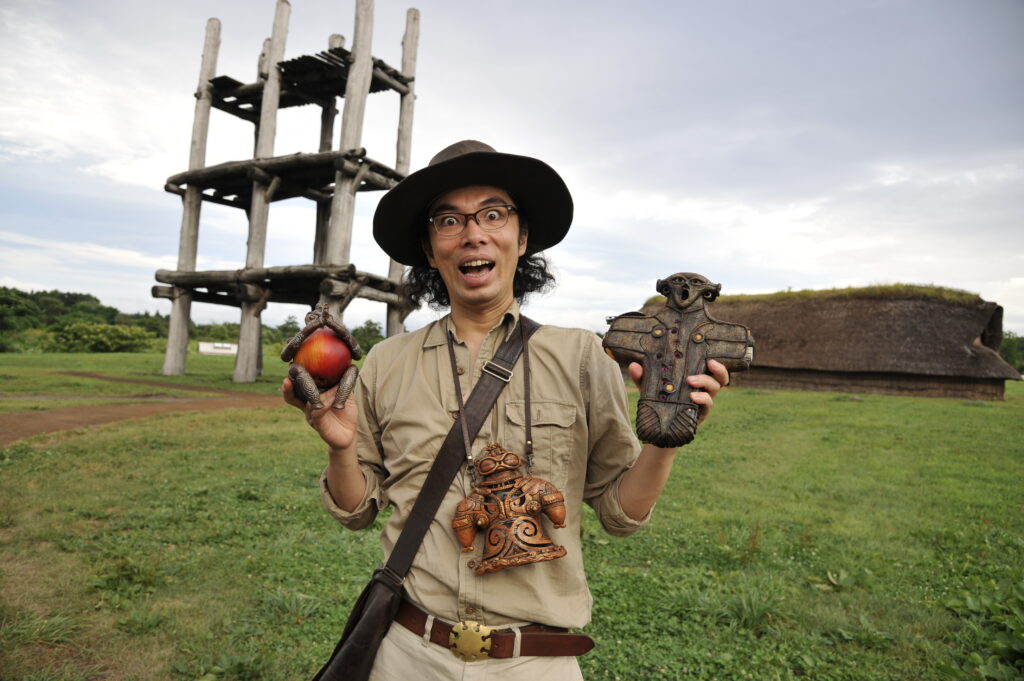
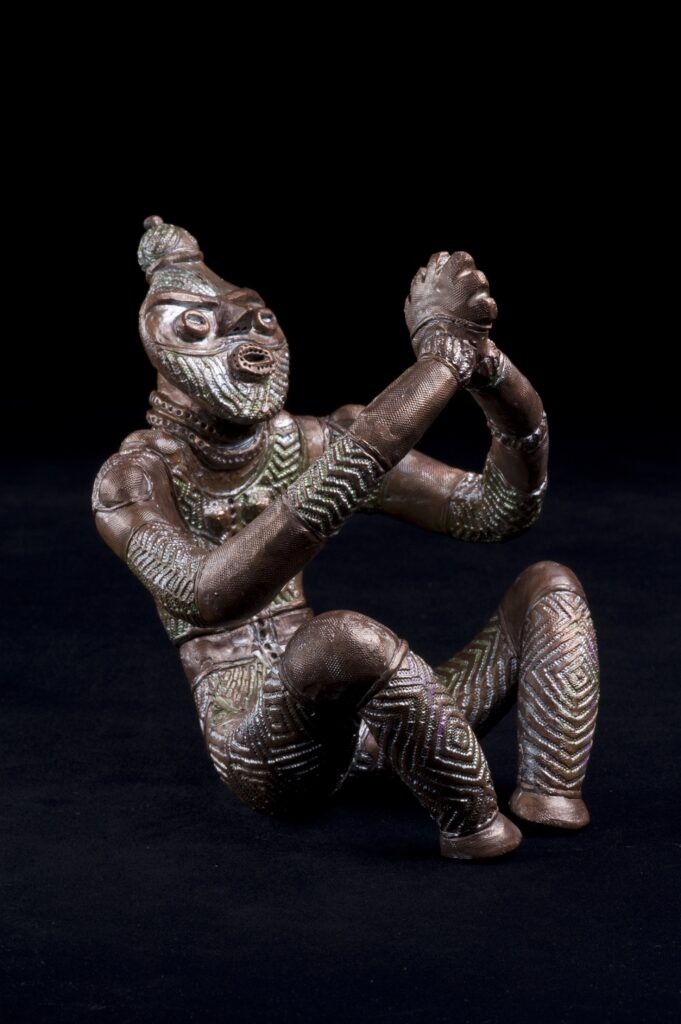
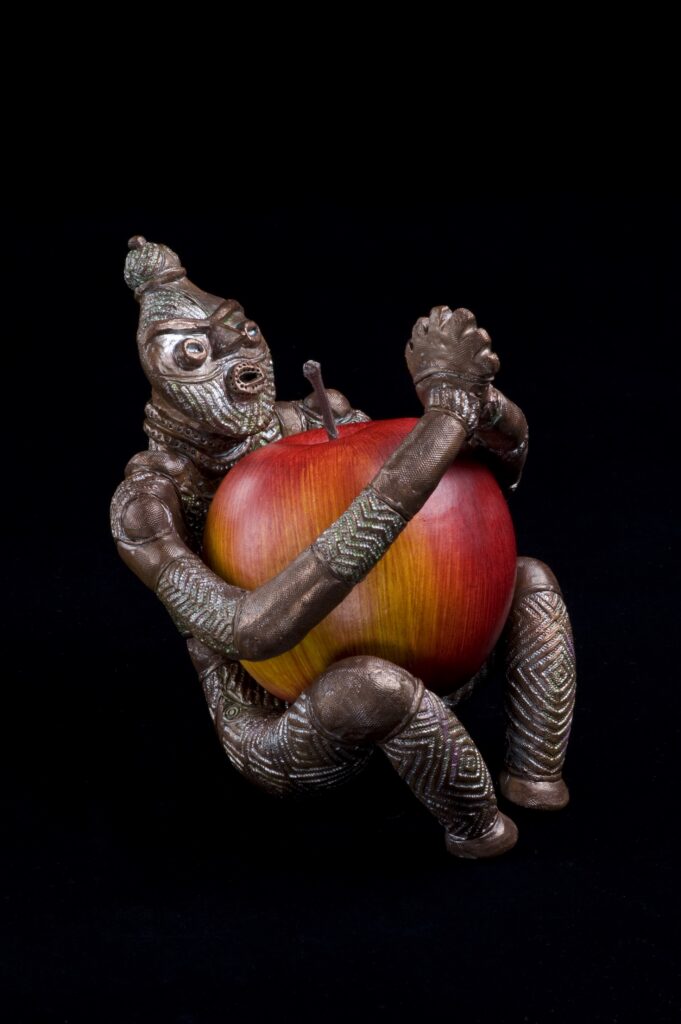
法量:縦×幅×奥行=160×120×120(mm)
材料:パテ 、スカルピー、アルミ線
Legal amount : Length x Width x Depth=160×120×120(mm)
Materials: putty, sculpey, aluminum wire
八戸の是川縄文館で見た、国宝『合掌土偶』。他は色々展示してあるのに、合掌土偶のためだけの専用ルームに「国宝ってスゴいことなんだな〜価値が!」とビックリしました。
ただ、遮光器土偶に比べると、それほど宇宙人ぽさはなく、この体勢であることが合掌土偶のアイデンティティだと感じたので、これをアレンジしちゃうとよくわからなくなると思って、ほぼそのままのシルエットで再現しました。ただ、青森らしさを出したかったから林檎は抱えさせてね。
ただ、実際に作ってみるとこれも奥が深い・・・。スネや太ももなど、縄文が入っている場所と消している場所の違いとか、函館の『中空土偶』に通ずる顔の塩梅。平面的なのに難しい…。色は林檎を目立たせるために茶色にして、メタリックで墨入れを施して、スペーシー感を入れましたよ。難しくて楽しかったです。
I checked out the National Treasure “Gassho Dogu” (Joining the palms together clay figure) at the Korekawa Jomon Museum in Hachinohe. I was surprised to see a room dedicated just for the Gassho Dogu, even though there were many other exhibits in the museum. “Being a national treasure is an amazing thing, the value!”
However, compared to the Shakouki Dogu, it is not so alien-like, and I felt that this position was the identity of the Gassho Dogu, so I thought it would be confusing if I rearranged it, so I reproduced the silhouette almost as it was. However, I wanted to give it an Aomori feel, so I let it hold an apple.
However, when you actually make it, it is also very deep… The difference between the parts with Jomon and the parts without Jomon, such as the legs and thighs, and the shape of the face, which is similar to Hakodate’s “Hollow Clay Figure”. It’s difficult to create something so flat… I used brown for the apple to make it stand out, and inked it with metallic ink to give it a cosmic feel. It was difficult and fun.
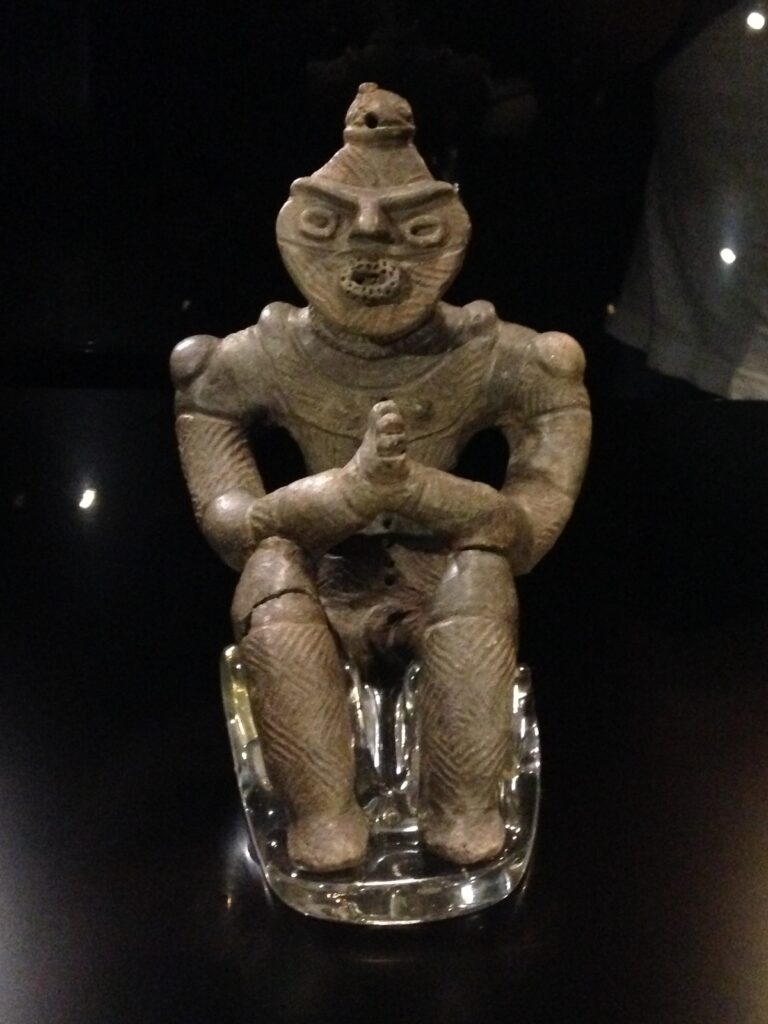
1997年6月30日、青森県八戸市風張遺跡から出土
2009年3月19日国宝となる。
この土偶は、膝を立てて座り胸の前で手を合わせるその姿から「合掌土偶」と呼ばれています。竪穴住居から右側面を下に正面を住居中央に向けた状態で、左足部分が欠けた状態で発見されたそうです。その後、2.5m離れたところから左足部分が出土。土偶は、一般的に捨て場や遺構外からの出土例が非常に多いですが、住居の片隅に置かれた様な状態で出土した例は非常に少ないそうです。さらに、この割れた左足部分にアスファルトが付着していたことから、壊れたモノを修復して大事にしていた土偶なのではないかと言われています。
Excavated the Kazahari 1 Site, Aomori city, Aomori Prefecture
Became National Treasure on 19 March 2009.
This clay figurine is called “Gassho Dogu” because of the way it sits with its knees up and its hands clasped in front of its chest. It was found in a pit dwelling with the right side down and the front facing the center of the dwelling, with the left foot missing. Later, the left foot part was excavated from 2.5 meters away. In general, clay figurines are often unearthed from dumping grounds or outside the remains, but there are very few cases where they are found in a corner of a house. In addition, asphalt was found on the broken left foot, suggesting that the clay figurine may have been a broken object that was repaired and cherished.
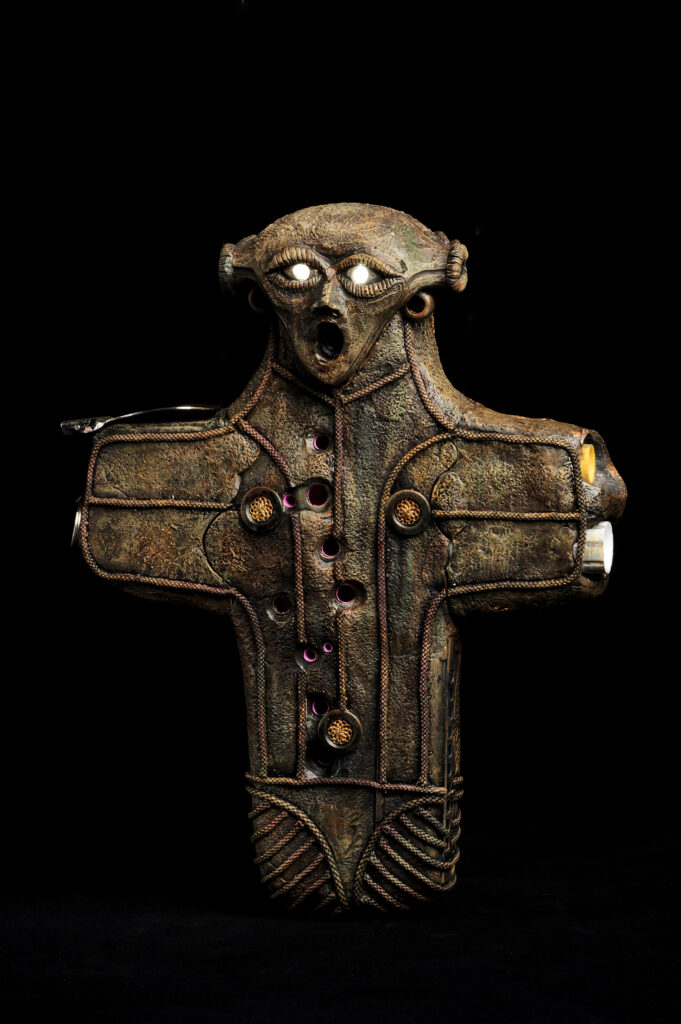
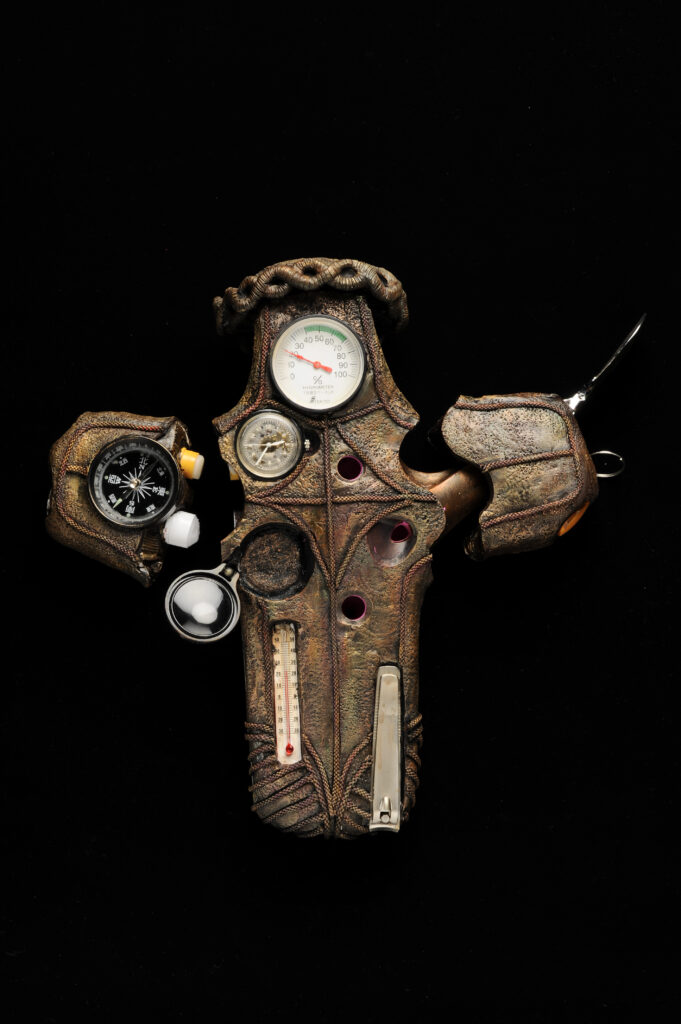
法量:縦×幅×奥行=280×220×45(mm)
材料:パテ、スタイロフォーム、ガラス、鉄、アクリル
Legal amount : Length x Width x Depth=280×220×45(mm)
Materials: Putty, styrofoam, glass, iron, acrylic
「青森土偶トリロジー」(『ペットボ土偶』・『合掌土偶2』・『便十土偶』)の最後の作品。
三内丸山遺跡で発掘された『板状土偶(十字形土偶ともいう)』がなんとも平板で、地味に感じてしまったため(実はグッズにしやすいデザイン)、ムダな便利機能満載で作ったら、当時小1の長男太朗が「それカッコいい!」を連発していました。
”便”利な機能が、”十”種入っている(オカリナ、ハーモニカ、方位磁石、リップ、スティックのり、ルーペ、ライト、時計、温度計、湿度計、靴べら、防犯ブザー、爪切りなど、十種類以上…)のが、小学生男子のハートを鷲掴みにしたんだと思います。オカリナとハーモニカを並べたことで、意外と大きくなってしまいました。
板状土偶のパンツを履いてるデザインと十字のシルエットが好きです。作りごたえがありましたね。もうちょっと十種の機能をイメージしたカラーリングにすればよかったかも。
This is the last work in the “Aomori Dogu Trilogy” (“Pet bottle in Dogu”, “DOGU with Palms Together Second Season”, and “Ten Convenient Dogu”).
The “Banjo Dogu” (also called “Cruciform Dogu”) excavated at the Sannai-Maruyama Site was so flat and plain that I felt it was too simple (actually, it was designed to be easy to make into goods). I made it with a lot of useless and convenient features, and my oldest son Taro, who was in the first grade at the time, kept saying, “That’s cool!”
I think the fact that it contains ten different useful functions (ocarina, harmonica, directional magnet, lipstick, glue stick, loupe, light, clock, thermometer, hygrometer, shoehorn, security buzzer, nail clippers, and more than ten others…) won the hearts of elementary school boys. The ocarina and harmonica side by side made it surprisingly big.
I like the design of the flat clay figurine wearing pants and the silhouette of the cross. It was very well made. Perhaps the coloring should have been a little more inspired by the ten different functions.
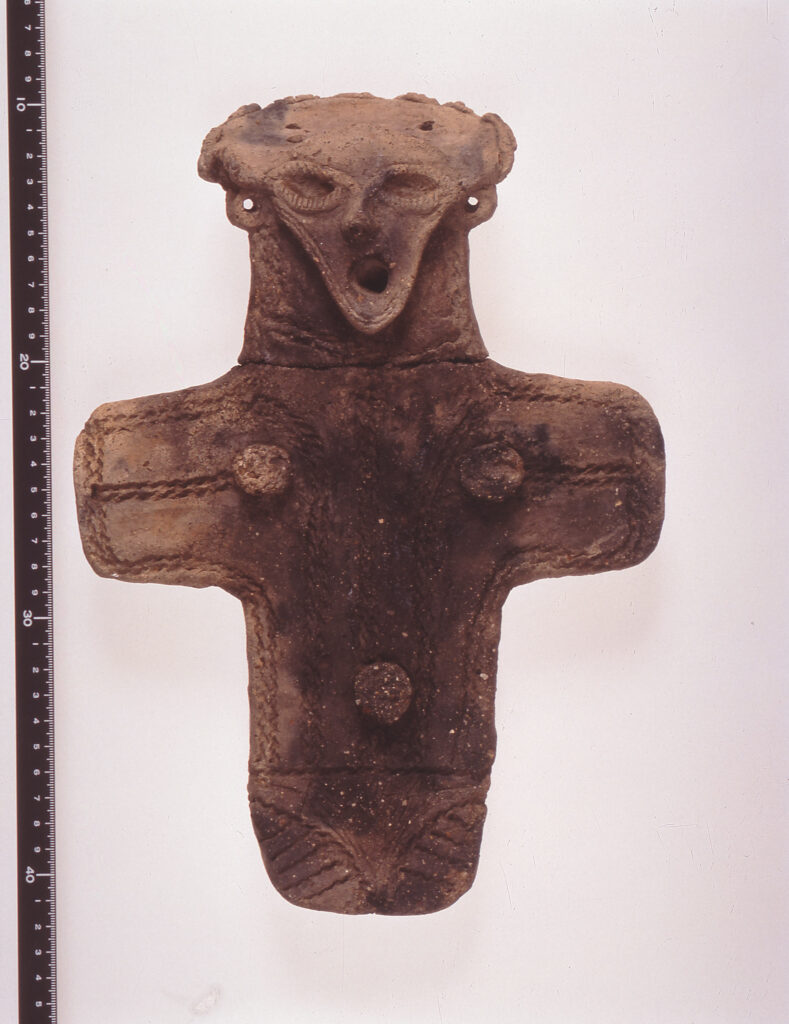
青森県三内丸山遺跡から出土した、縄文時代中期の十字型土偶。立像土偶やポーズ土偶が誕生している縄文時代中期初頭に、東北地方北部では板状土偶の系譜をひく土偶が伝統的に作られていたそうです。この三内丸山遺跡からは、扁平で十字型をしている板状土偶など1700点以上の土偶が出土しているそうです。
At the beginning of the mid-Jomon period, when standing clay figurines and poseable clay figurines were born, clay figurines with the lineage of plate-shaped clay figurines were traditionally made in the northern Tohoku region. More than 1,700 clay figurines, including flat and cross-shaped clay figurines, have been excavated from the Sannai Maruyama Site.
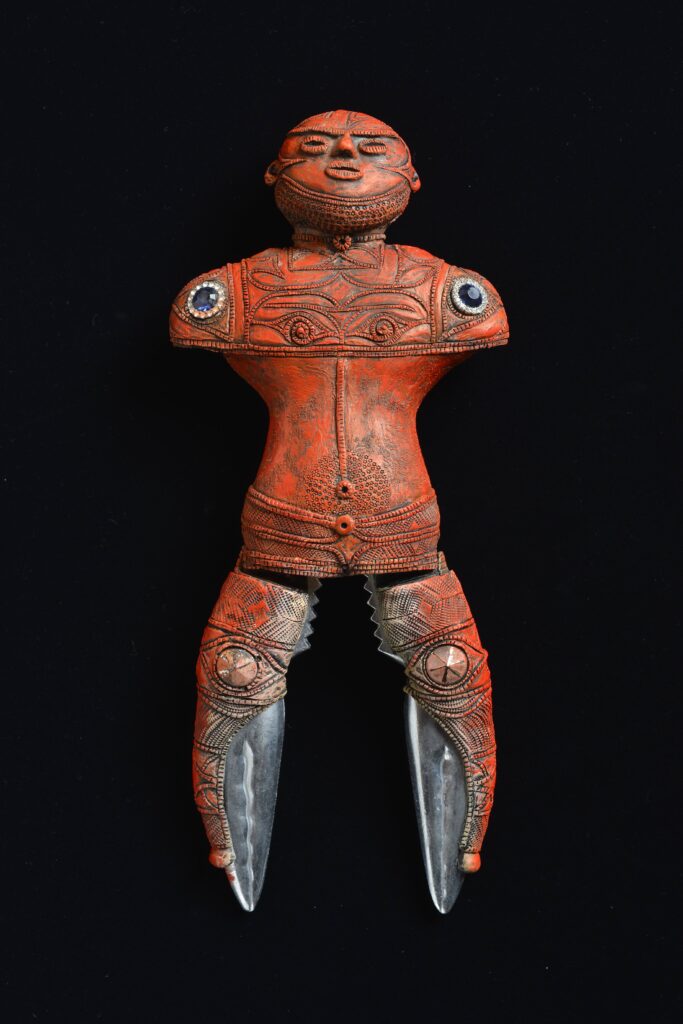
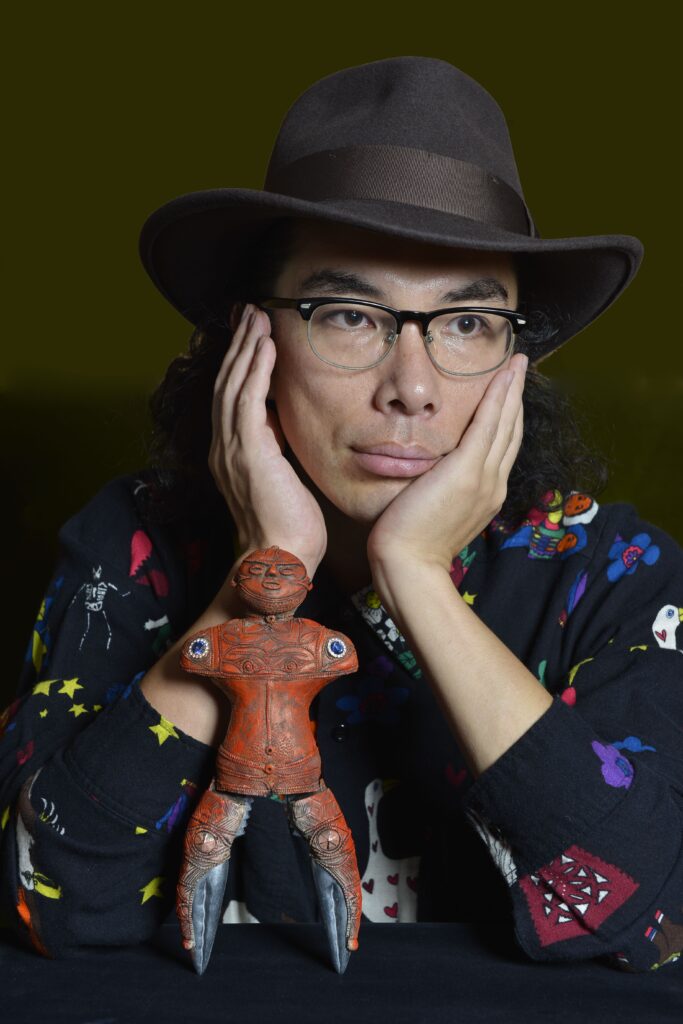
法量:縦×幅×奥行=250×100×40(mm)
材料:パテ、スカルピー、サファイヤ
Legal amount : Length x Width x Depth=250×100×40(mm)
Materials: putty, sculpey, sapphire
ギリ展を開催した札幌パルコからの帰りに、北海道庁に寄って「中空土偶」のレプリカを見たんです。 その完成度の高さ、分厚さ、男らしさ(女性をモチーフにしてるそうですが)に一発でヤラれました。「こりゃ会期中に作るしかない!」とばかりに制作に着手したんですが、このちょっとアイヌ模様っぽい線を、 出来るだけ正確にトレースするのは大変でした。縄文の時代にも日本人のものづくり へのこだわりがあったことを実感しましたね。顔は作りごたえがありました。
下半身に配置した『カニ割り』は以前から家にあっ たんですが、一切使ってなかったので、いい供養になったな〜と。北海道にこれ使ってカニ食べる人いないですよね。カラーはカニに寄せて赤っぽくしました。
『中空土偶』を無理矢理ボキャブった『超カニ喰う土偶』という作品名は気に入ってます。
On my way back from Sapporo Parco, where the Giri exhibition was held, I dropped by the Hokkaido Government Office to see a replica of the “Hollow Clay Figure”. I was immediately struck by its high degree of perfection, its thickness, and its masculinity (I heard it was based on a female motif). “I had no choice but to make it during the exhibition”. I started to work on it, but it was hard to trace the lines that looked a bit like Ainu patterns as accurately as possible. I realized that even in the Jomon period, the Japanese were very particular about their craftsmanship. The face was a great challenge to make.
The “crab cracker” placed on the lower half of my body has been in my house for a long time, but I never used it, so I thought it was a good memorial service. There’s no one in Hokkaido who eats crab using this, is there? The color is reddish to resemble crabs.
I like the name of the work, “Cho Kani Kuu Dogu(in Japanese),” which is a forced vocab of “Hollow Clay Figurine”.
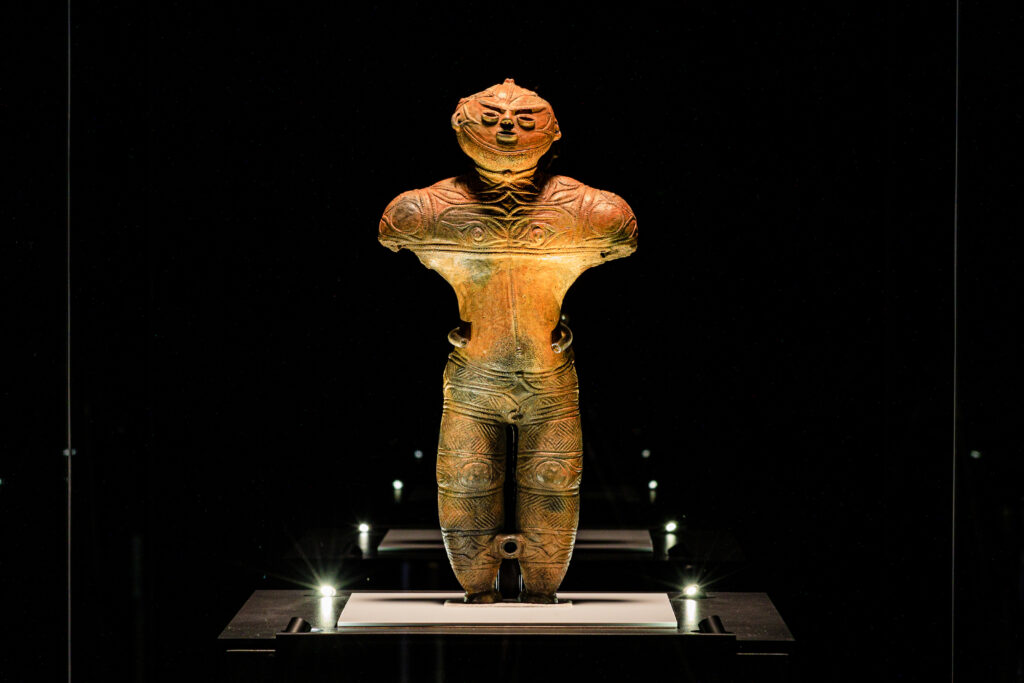
1975(昭和50)年に、函館の旧南茅部町で発見された縄文時代後期の土偶。北海道唯一の国宝として、函館市縄文文化交流センターで常設展示されているそうです。内部が空洞になっている「中空土偶」としては国内最大級で、最も薄いところで厚さ数ミリという精巧な作りが特徴です。出土した南茅部エリアの「茅」と空洞の「空」から、「茅空」という愛称で親しまれているそうです。
全身に〇や△で構成された繊細な幾何学文様が施されていて、ふっくらとしたフォルムや妊娠線など女性的な表現と髭や眉など男性的な表現が混在する姿が特徴的です。
This clay figurine from the late Jomon period was discovered in 1975 in the former Minami Kayabe town of Hakodate.It is said to be the only national treasure in Hokkaido and is on permanent display at the Hakodate Jomon Culture Center in Hakodate.It is one of the largest “hollow clay figurines” in Japan with a hollow interior, and is characterized by its elaborate construction, being only a few millimeters thick at its thinnest point.It is said to be nicknamed “Kakku,” from the “kaya” of the Minamikayabe area where it was excavated and the “kuu” of the hollow.
The whole body is decorated with delicate geometric patterns composed of circles and triangles, and the figure is characterized by a mixture of feminine expressions such as plump forms and stretch marks, and masculine expressions such as beards and eyebrows.
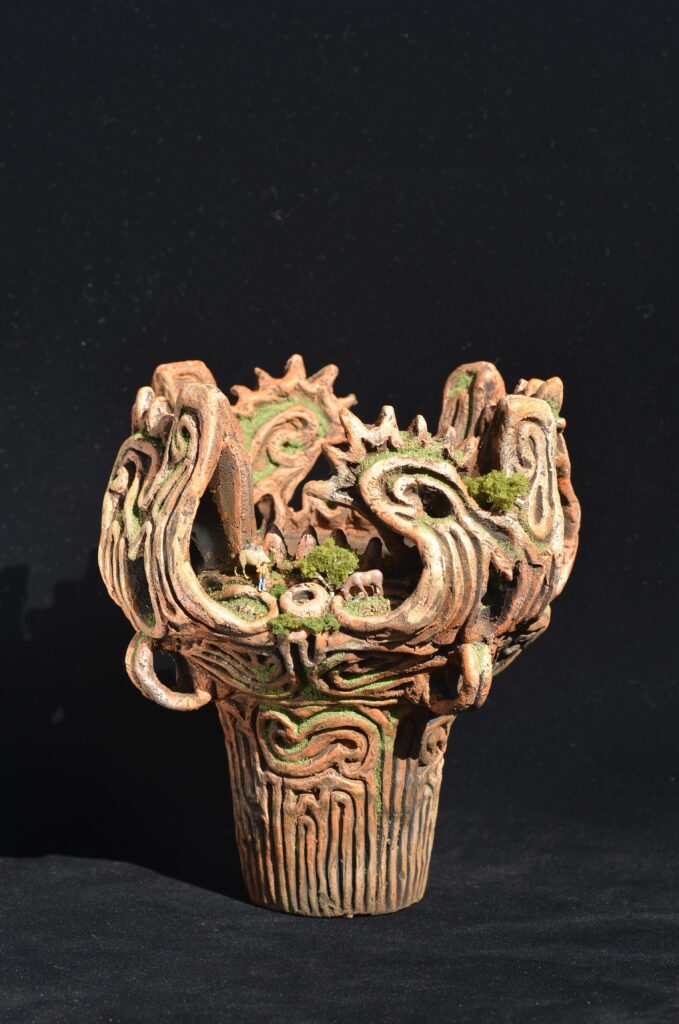
法量:縦×幅×奥行=235×215×215(mm)
材料:陶土、シーナリーパウダー
Legal amount : Length x Width x Depth=235×215×215(mm)
Materials: Pottery clay, Scenery powder
これは、自分で旅をプロデュースする TV 番組「旅デューサー」で行った新潟県の馬高縄文館で、火焔土器づくりの名人に教えてもらいながら作りました。すぐ近くに重要文化財の火焔土器があるので、それをちょくちょく見に行って作れるという、とても贅沢な体験をさせてもらいました!完成後に本物の火焔土器を見ると、最初に見た時とは全く違うものに見えたんです!
要するにじっくり観察しているつもりでも、作ってみるまで”うねりの奥行き”みたいなものが、見えてなかったってことです。あんな体験したことない。
家に持ち帰ってから、その繊細な作りを見せるには「超古代文明のジオラマだ!」と気付きました。シーナリーパウダーなどでコケや植物をくっ付けたりして、上には動物もいます。”縄文土器のスケール感”ってこういう感じがするんですよね。日本人のもの作り集大成って感じです。
I made this with the help of a master pottery maker at the Umataka Jomon Museum in Niigata Prefecture, which I visited as part of a TV program to produce my own trip. There is an important cultural asset, Jomon Vessel with Flame-like Ornamentation, very close by, so it was a very luxurious experience for me to be able to visit it every now and then and make it! When I looked at the real flaming earthenware after completion, it looked completely different from the first time I saw it!
In short, I thought I was observing carefully, but I didn’t see the “depth of the swell” until I made it. I’ve never experienced anything like that.
When I brought it home, I realized that to show off its delicate construction, it was a diorama of a very ancient civilization! I used scenery powder and other materials to attach moss and plants to it, and there are animals on top.” The scale of Jomon pottery” is like this, I think. It’s like the culmination of Japanese craftsmanship.
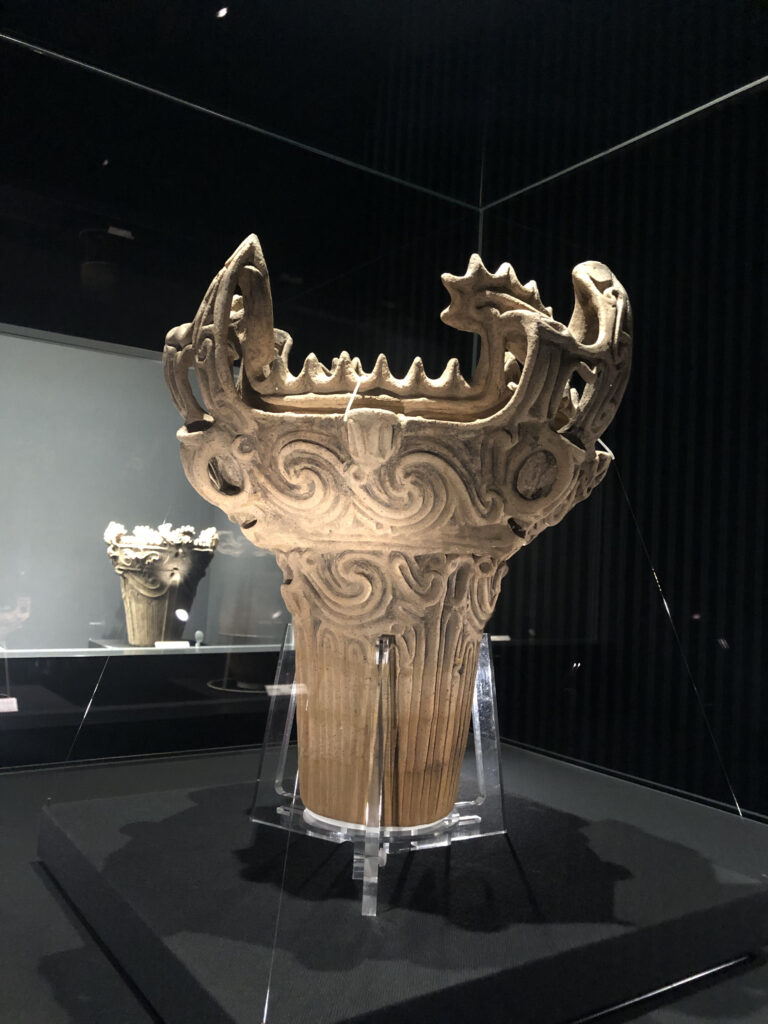
縄文時代(中期)前3000〜前2000年
高さ350mm 口径280mm 胴径200mm 重量5155g
新潟県十日町市 野首遺跡出土
火焔型土器は今から約5,000年前の縄文時代中期に造られた土器で、大きく立ち上がる突起が、燃え盛る炎のように見えることから「火焔型土器」と命名されたそうです。縄文時代中期頃に現在の新潟県域で栄えた土器様式で、平縁の口縁に鶏頭冠突起とよばれる4つの突起があり、突起と突起の間には鋸歯状の小突起があります。
この独特な形や文様は、近隣各地の土器様式の影響のもと、前3,300年頃に信濃川中流域で成立し同地域のなかで継続、発展したと推定されているそうです。
The middle period of the Jomon era (B.C. 3000~ B.C. 2000)
Height 350mm, Mouth diameter 280mm, Carcass diameter 200mm, Weight 5155g
Excavated : Nokubi Site, Toka machi city, Niigata Prefecture
Jomon Vessel with Flame-like Ornamentation was made about 5,000 years ago, in the middle of the Jomon period, and was named “Jomon Vessel with Flame-like Ornamentation” because its large protrusions look like burning flames. It is a style of earthenware that flourished around the middle of the Jomon period in what is now Niigata Prefecture. It has four projections called chicken head crown projections on the mouth edge of the flat rim, and small serrated protrusions between the protrusions.
It is estimated that this unique shape and pattern was established in the middle reaches of the Shinano River around 3,300 B. C. under the influence of pottery styles from neighboring regions, and continued and developed in the same region.
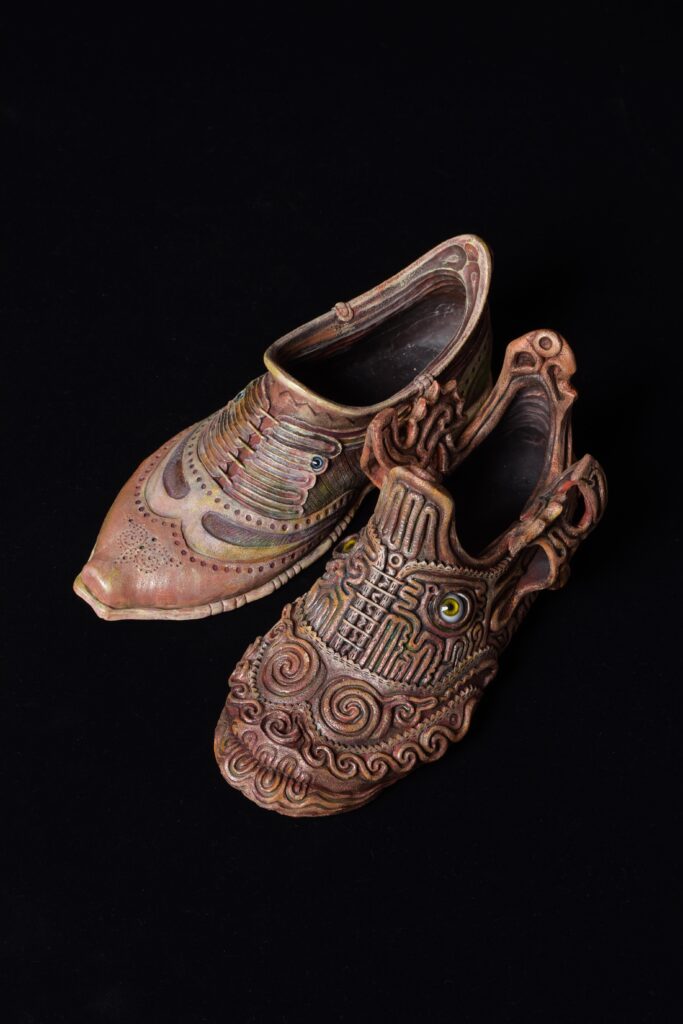
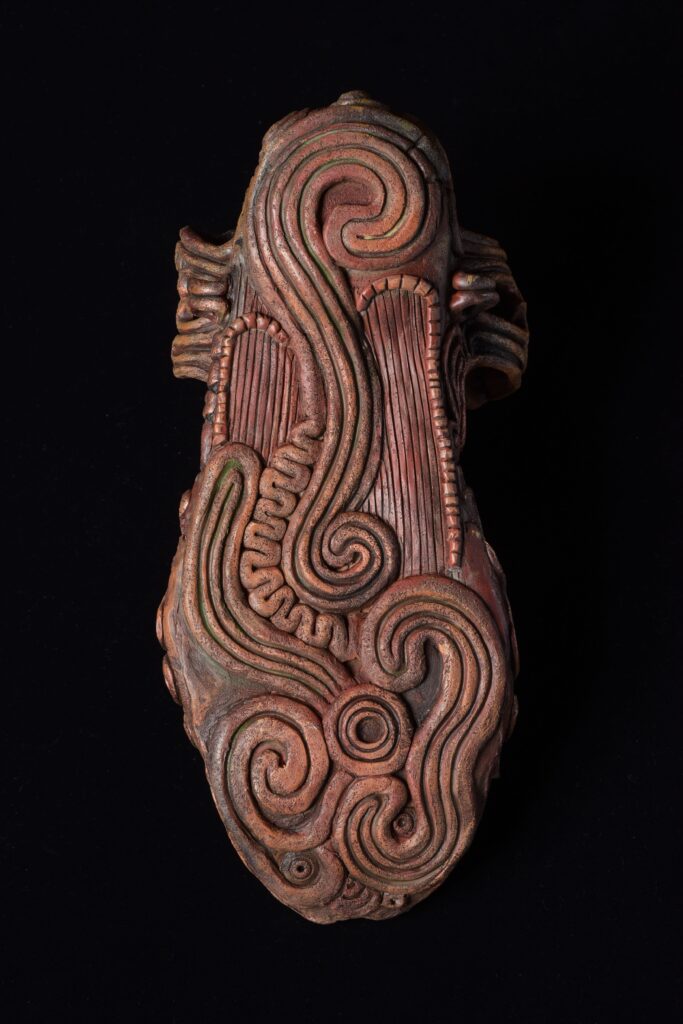
縄文靴 法量:縦×幅×奥行=290×120×150(mm)
弥生靴 法量:縦×幅×奥行=290×120×120(mm)
材料:エポキシパテ・スカルピー・ハンダ線
Jomon Shoes Legal amount : Length x Width x Depth=290×120×150(mm)
Yayoi Shoes Legal amount : Length x Width x Depth=290×120×120(mm)
Material: Epoxy putty, sculpey, solder wire
『シン・ゴジラ』『ゼイラム』でおなじみの造形家、竹谷隆之さんが作ったオリジナルフィギュア” 縄文傀儡”とのコラボ作品。くぐつなので”靴”にしました。ちょうどNHKで長岡の縄文番組に出た直後だったので縄文熱が再熱してて、前後が王冠土器、左 右が火焔土器、足裏が水煙土器という入れ込みすぎな感じも気に入ってます。
靴は前々から作ってみたかったので、楽しかったです。
あと、左足の縄文靴完成後、右足を” 弥生”にしようと作り始めたけど、弥生の知識が全然なくて困りましたね…。最近になって、弥生土器も面白いことが分かって来ました。
I collaborated with Takayuki Takeya, the sculptor known for “Shin Godzilla” and “Zeiram”, to create an original figure called “Jomon Kugutsu (Puppet)”. Since it is called a ” kugutsu”, I decided to make it into a “Kutsu (shoe)”.It was right after I appeared on NHK’s Jomon program in Nagaoka, so my Jomon fever was rekindled, and I like the way it looks with the crown pottery on the front and back, the Jomon Vessel with Flame-like Ornamentation on the left and right, and the swirling water-flame patterned pot on the sole.
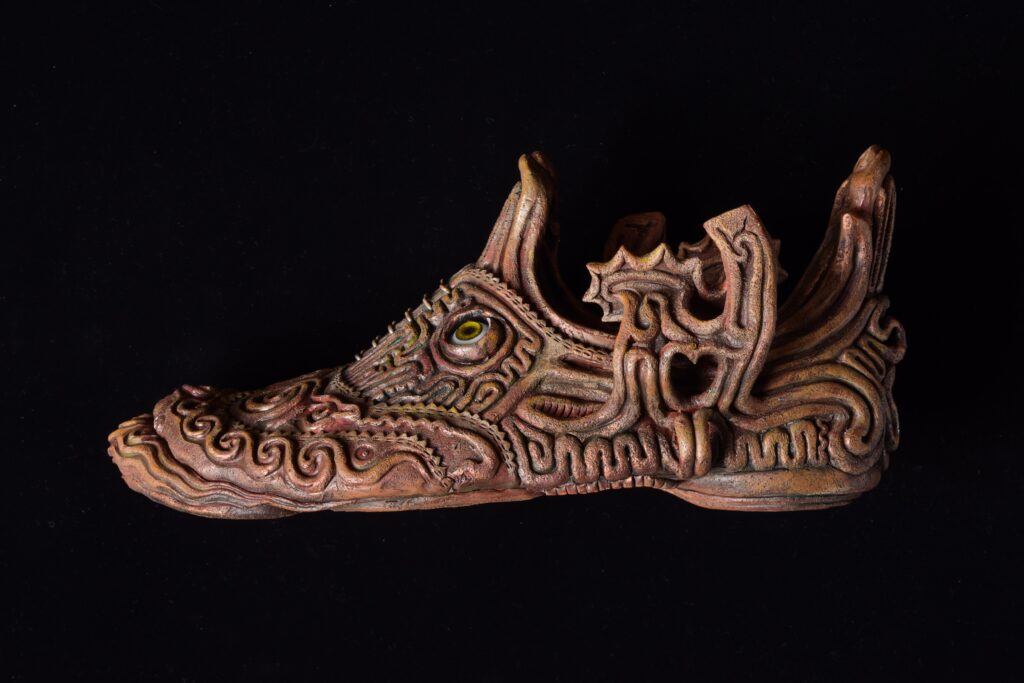
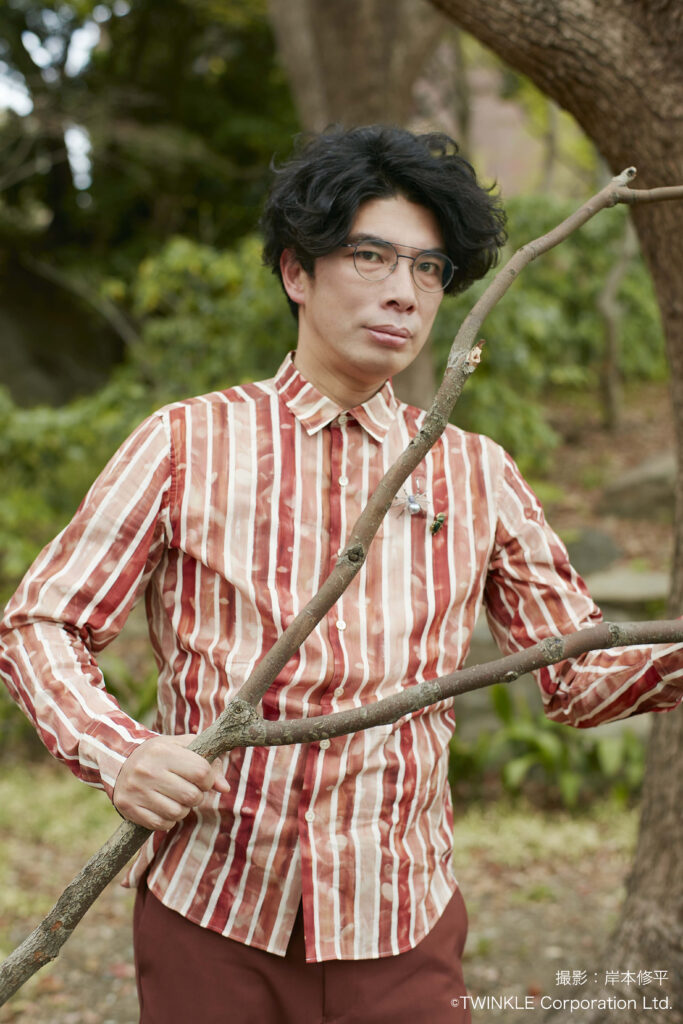
片桐 仁
1973年11月27日生まれ / 埼玉県出身 / 多摩美術大学卒業
ドラマを中心に舞台、映画、ラジオなどで活躍中。近年の主な出演作は「99.9%-刑事専門弁護士-」(TBS)、「あなたの番です」(NTV)、「NHK 連続テレビ小説 エール」(NHK)などがある。
俳優業の傍ら粘土創作活動も行い、2016年から2018年までは「片桐仁不条理アート粘土作品展 ギリ展」にて全国ツアーを開催。2019年は初の海外個展を台湾で開催している。
Jin Katagiri
Born November 27, 1973 / Born in Saitama Prefecture / Graduated from Tama Art University
Active in the stage, movies, radio, etc., mainly in TV dramas series. Major appearances in recent years include “99.9% -Criminal Lawyer-” (TBS), “Your Turn to Kill” (NTV), and “NHK Morning drama series Yell” (NHK).
In addition to acting, he also creates clay, and from 2016 to 2018 he held a national tour at the “Jin Katagiri Absurdity Clay Art Exhibit Giri Ten.” In 2019, he is holding his first overseas solo exhibition in Taiwan.
・東京国立博物館 特別展 縄文―一万年の美の鼓動
JOMON: 10,000 Years of Prehistoric Art in Japan
・八戸市HP
Hachinohe city official Home Page
・JOMON ARCHIVES
Jomon Japan
・函館市観光部「函館市公式観光情報」
Travel Hakodate
世界遺産登録となった「北海道・北東北の縄文遺跡群」をはじめ日本全国からとってもユニークな縄文土器、土偶が発掘されています。当時は祈りの道具としてつくられていたであろう土偶たちですが、片桐さんの「カニを食べるための土偶」「便利な道具がセットされた土偶」などは、目的を持っているという点では縄文時代の土偶達と同じなのかも。あれ?では火焔型土器の造形の目的はなんだろう?「???」とあとがきを書きながら「?」のループにはまりました。縄文土器や土偶については事実が不確定なぶん自由に想像して楽しめるところも魅力なのかもしれません。
Many unique Jomon pottery and clay figurines have been unearthed all over Japan, including the Jomon Prehistoric Sites in Northern Japan, which have been registered as World Heritage sites. At the time, these clay figurines were probably made as tools for prayer, but Katagiri’s “clay figurines for eating crabs” and “clay figurines with useful tools” are probably the same as Jomon clay figurines in that they have a purpose. Huh? So what is the purpose of the modeling of flame-shaped earthenware? ? I was stuck in a loop of “?”.Perhaps the appeal of Jomon pottery and clay figurines lies in the fact that the facts are indeterminate, so we can freely imagine and enjoy them.
土器/土偶説明・あとがき:THAT IS GOOD編集部 藤田
Explanation of Jomon vessel, DOGU and Afterwords : THAT IS GOOD editorial department, Fujita